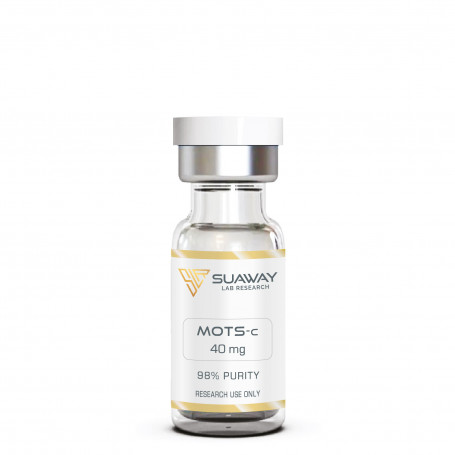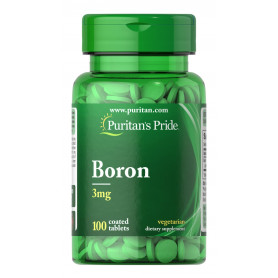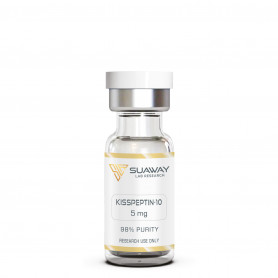MOTS-c - 40 mg
The mitochondrial-derived peptide MOTS-c enhances exercise capacity and lowers obesity, insulin resistance, and other disease processes including osteoporosis while promoting metabolic homeostasis and life.
- According to research, MOTS-c is helpful for the following:
- Muscle Metabolism
- Fat Metabolism
- Insulin Sensitivity
- Osteoporosis
- Longevity
- Heart Health
Description
STRUCTURE
Sequence: Met-Arg-Trp-Gln-Glu-Met-Gly-Tyr-Ile-Phe-Tyr-Pro-Arg-Lys-Leu-Arg
Molecular Formula: C101H152N28O22S2
Molecular Weight: 2174.64 g/mol
CAS Number: 1627580-64-6
Peptide Purity: Greater than 98%
Other details: No TFA Salt, No Mannitol
Storage: Lyophilized peptide must be stored at -20°C and peptide solution at 4°C.
MOTS-c has low oral and excellent subcutaneous bioavailability.
DESCRIPTION
A component of the wider family of mitochondrial-derived peptides, MOTS-c is a short peptide that is encoded in the mitochondrial genome (MDPs). Recent research has shown that MDPs are bioactive hormones with crucial functions in energy control and mitochondrial communication. A new study has shown that many MDPs, which were previously believed to be solely associated with the mitochondria, are active in the cell nucleus and that a few even enter the bloodstream to have systemic effects. MOTS-c is a recently discovered MDP that has been shown to play significant roles in the control of weight, exercise capacity, lifespan, and even the processes that result in disease states such as osteoporosis. MOTS-c is a real natural hormone since it has been discovered in the nuclei of cells and the bloodstream as a whole. Due to its potential as a treatment, the peptide has been the subject of much investigation during the past five years.
Muscle Metabolism
The MOTS-c may be able to improve muscle glucose uptake by reversing age-dependent insulin resistance, according to research. This is achieved by enhancing the expression of glucose transporters in skeletal muscle in response to AMPK activation. The fact that this activation is not reliant on the insulin route makes it possible to increase muscle glucose absorption even in the absence or inadequate supply of insulin. The end outcome is a reduction in functional insulin resistance and an improvement in muscle development and function.
Fat Metabolism
Low estrogen levels have been linked to increased fat accumulation and abnormal adipose tissue, according to research. In this situation, there is a higher chance of getting insulin resistance and, ultimately, diabetes. However, giving mice MOTS-c supplements improves brown fat function and decreases the buildup of adipose tissue. The peptide also seems to stop the inflammation and malfunction of adipose tissue, which usually comes before insulin resistance. The AMPK pathway seems to be activated as a mechanism by which MOTS-c affects fat metabolism, at least in part. This well-defined route mediates the absorption of both glucose and fatty acids by cells for metabolism and is activated when cellular energy levels are low. The methionine-folate cycle is the focus of MOTS-c, which also raises AICAR levels and activates AMPK.
New research shows that MOTS-c can leave the mitochondria and go to the nucleus, where it can change how genes are expressed in the nucleus. It has been shown that MOTS-c controls nuclear genes implicated in glucose restriction & antioxidant responses in response to metabolic stress. Evidence from mice suggests that MOTS-c is a crucial regulator of sphingolipid, monoacylglycerol, & dicarboxylate metabolism, especially in the context of obesity. MOTS-c seems to decrease fat storage by decreasing these pathways and enhancing beta-oxidation.
Insulin Sensitivity
Only lean people have an association between protein and insulin sensitivity, according to studies that compare the levels of MOTS-c in insulin-resistant and insulin-sensitive people. In other words, MOTS-c seems to be crucial for insulin insensitivity development but not for maintaining the condition. The peptide may be a valuable tool for tracking pre-diabetic slim people, and variations in MOTS-c levels may serve as an early indicator of possible insulin sensitivity, according to scientists. In this situation, using MOTS-c supplements may help prevent the development of insulin resistance and diabetes. Although mouse studies have thus far shown promise, further research is necessary to fully comprehend MOTS-effects c's on insulin control.
Osteoporosis
It appears that MOTS-c adds to osteoblasts' production of type I collagen in bone. Osteoblast survival and health are regulated by the TGF-beta/SMAD pathway, according to studies on osteoblast cell lines. MOTS-c aids in improving type I collagen production and, thus, bone strength and integrity. Further research into osteoporosis has shown that the same TGF-beta/SMAD pathway is used by MOTS-c to encourage bone marrow stem cell differentiation. This directly caused enhanced osteogenesis in the research (formation of new bone). Thus, osteoblasts are not only protected and given a better chance of surviving, but MOTS-c also helps them grow from stem cells.
Longevity
In some human groups, such as the Japanese, research on the peptide MOTS-c has shown a unique alteration that is linked to longevity. In this instance, the MOTS-c gene mutation results in a glutamate residue replacing the lysine that typically resides in position 14 of the protein. However, given that glutamate has fundamentally different characteristics than lysine and would alter both the structure and the function of the MOTS-c gene, it is virtually guaranteed that this alteration would disrupt the functional features of the protein. This alteration is unique to persons of Northeast Asian descent and is likely to contribute to the high lifespan seen in this community, while further study is needed to understand how it impacts function.
The School of Gerontology at USC Leonard Davis researcher Dr. Changhan David Lee believes that mitchondrial biology is the key to expanding the human lifetime and health span. Being the most significant metabolic organelle, the mitochondria are "implicated in aging and age-related illnesses." Up until recently, the only effective way to influence mitochondrial activity and, hence, lifespan was via food restriction. However, it may be feasible to more directly affect mitochondrial activity using peptides like MOTS-c.
Heart Health
Researchers have shown that individuals with lower blood levels of MOTS-c had greater degrees of endothelial cell dysfunction during coronary angiography in humans. In blood arteries, endothelial cells line the interior and play a crucial role in controlling blood pressure, blood clotting, or plaque development. Even while MOTS-c does not directly influence blood vessel responsiveness, further rat study indicates that it does make endothelium cells more susceptible to the effects of other signaling molecules, such as acetylcholine. It has been shown that giving rats MOTS-c increases endothelial function as well as microvascular & epicardial blood vessel function.
Among mitochondria-derived peptides (MDPs), MOTS-c is not the only one to have an impact on heart health. According to research, at least three MDPs are important for defending heart cells against inflammation and stress. There is strong evidence to suggest that MDP dysregulation plays a significant role in the development of cardiovascular disease. The peptides could potentially have a significant role in endothelial function and reperfusion damage, as was already mentioned.
REFERENCES
R. Crescenzo et al., "A possible link between hepatic mitochondrial dysfunction and diet-induced insulin resistance" [PubMed]
N. Che et al., "MOTS-c improves osteoporosis by promoting the synthesis of type I collagen in osteoblasts via TGF-β/SMAD signaling pathway" [PubMed]
Q. Qin et al., "Downregulation of circulating MOTS-c levels in patients with coronary endothelial dysfunction" [PubMed]
C. Lee et al., "MOTS-c: A novel mitochondrial-derived peptide regulating muscle and fat metabolism" [PubMed]
L.R. Cataldo et al., "Plasma MOTS-c levels are associated with insulin sensitivity in lean but not in obese individuals" [PubMed]
N. Fuku et al., "The mitochondrial-derived peptide MOTS-c: a player in exceptional longevity?" [PubMed]
Y. Yang et al., "The role of mitochondria-derived peptides in cardiovascular disease: Recent updates" [PubMed]
H. Lu et al., "MOTS-c peptide regulates adipose homeostasis to prevent ovariectomy-induced metabolic dysfunction" [PubMed]
B-T- Hu et al., "MOTS-c improves osteoporosis by promoting osteogenic differentiation of bone marrow mesenchymal stem cells via TGF-β/Smad pathway" [PubMed]
DISCLAIMER
This product is intendend for lab research and development use only. These studies are performed outside of the body. This product is not medicines or drugs and has not been approved by the FDA or EMA to prevent, treat or cure any medical condition, ailment or disease. Bodily introduction of any kind into humans or animals is strictly forbidden by law. This product should only be handled by licensed, qualified professionals.
All product information provided on this website is for informational and educational purposes only.












